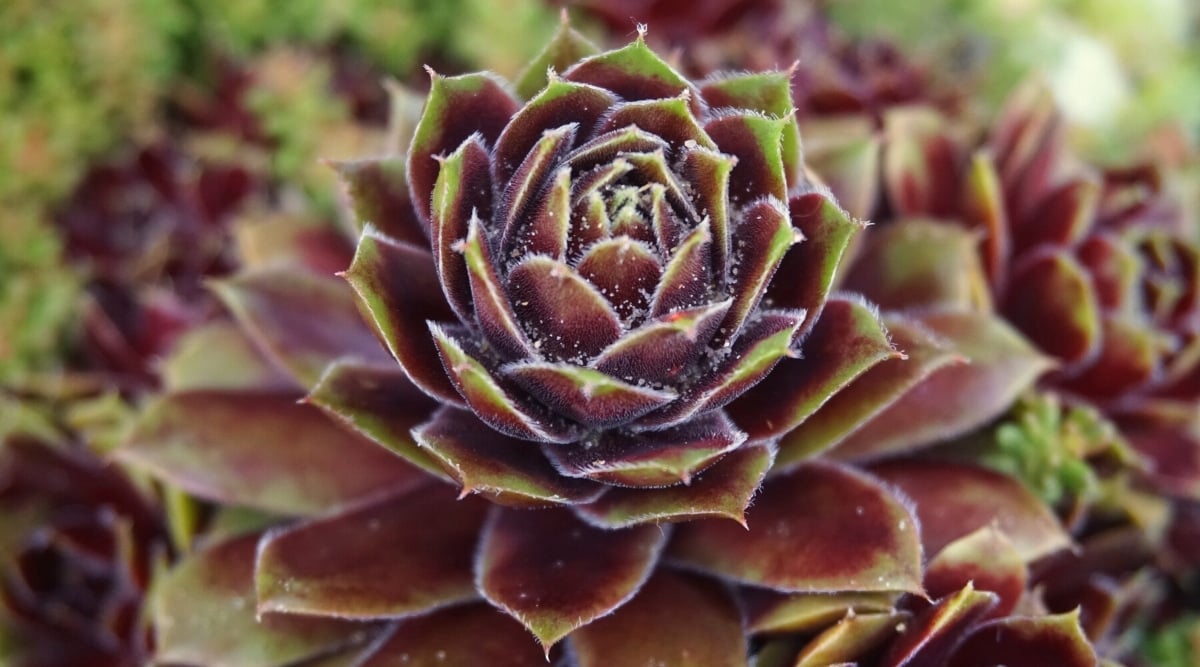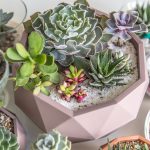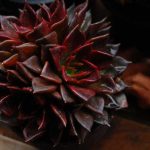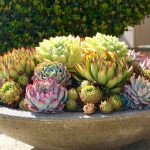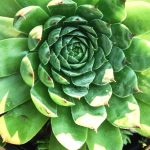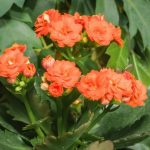Embrace the charm of unique purple succulents to enhance your garden. Melissa Strauss, a gardening aficionado, shares her top picks for vibrant purple succulents designed for both indoor and outdoor spaces.
Cacti & Succulents
Discover 37 Exquisite Purple Succulents
Embarking on a succulent garden project offers a delightful and rewarding experience, whether you envision an outdoor rock garden, a hanging basket arrangement, or an indoor assortment of these captivating plants. Succulents are generally low-maintenance, with overwatering posing the greatest risk to their well-being.
Exposure to sunlight often causes many succulents to display varying hues of red and purple. The production of anthocyanins as a response to sun exposure results in their beautiful transformation into shades of purple.
This fascinating chemical reaction gives rise to striking plants that significantly elevate the visual appeal of any succulent collection, injecting a burst of color and texture into your garden. Let’s explore a selection of the most sought-after purple succulents that thrive across diverse climates and excel as houseplants as well.
Echeveria ‘Afterglow’

|
|
botanical name Echeveria ‘Afterglow’ |
|---|---|
|
|
sun requirements Full Sun to Part Sun |
|
|
hardiness zones 9-12 |
Echeveria, my favored choice for container gardening, is a graceful succulent variety. With lavender rosettes that can reach a diameter of 12”, it boasts purple leaves with elegantly frilled edges and a delicate pink border that enhances its visual appeal. Highly resilient to heat and drought, Echeveria ‘Afterglow’ intensifies in color with increased sun exposure.
In the summer, Echeveria adorns itself with blooms. While many gardeners prune the flower spikes to promote growth, I find the blossoms to be exquisite. Sporting lavender stems and deeper purple leaves, ‘Afterglow’ mesmerizes with its soft coral flowers topping the 1’ tall branching spikes.
Sempervivum Heuffelii ‘Artemis’

A frost-tolerant succulent with a symmetrical shape, Sempervivum heuffelii ‘Artemis’ features green rosettes that transition to deep purple at the tips, eventually turning eggplant-hued during fall. This European plant thrives in full sun and well-drained soil, showing resilience to both heat and frost. Its leaves are coated with a protective white fuzz, ensuring its survival in various weather conditions. Even under snow cover, ‘Artemis’ continues to flourish through winter. In summer, ‘Artemis’ blooms beautiful yellow flowers, albeit terminally, with the parent plant perishing post-bloom. Nonetheless, the succulent produces numerous offsets, ensuring a continuous cycle of new plants. Sempervivum Heuffelii ‘Bermuda’
If you are unfamiliar with Sempervivum heuffelii, let me introduce you to this exceptional plant. Second on our list for a good reason, these plants are easy to grow, tolerant to both heat and frost, and reproduce generously through offsets. ‘Bermuda’ is a stunning succulent that undergoes mesmerizing color transformations. Described as purple to dark brown or even black, the Echeveria ‘Black Prince’ thrives in well-lit environments. Its coloration can transition to green under insufficient sunlight, making it a charming addition to any indoor collection. Remember to provide shelter for this plant if you reside in a region colder than Zone 9 to shield it from freezing temperatures. During the fall season, ‘Black Prince’ showcases its beauty by producing a flower spike that blooms into striking red flowers. As winter approaches, the plant goes dormant and requires minimal watering. For enthusiasts, there is a variegated variation of the ‘Black Prince’ known as Bess Bates. Aeonium Arboreum ‘Zwartkop’ 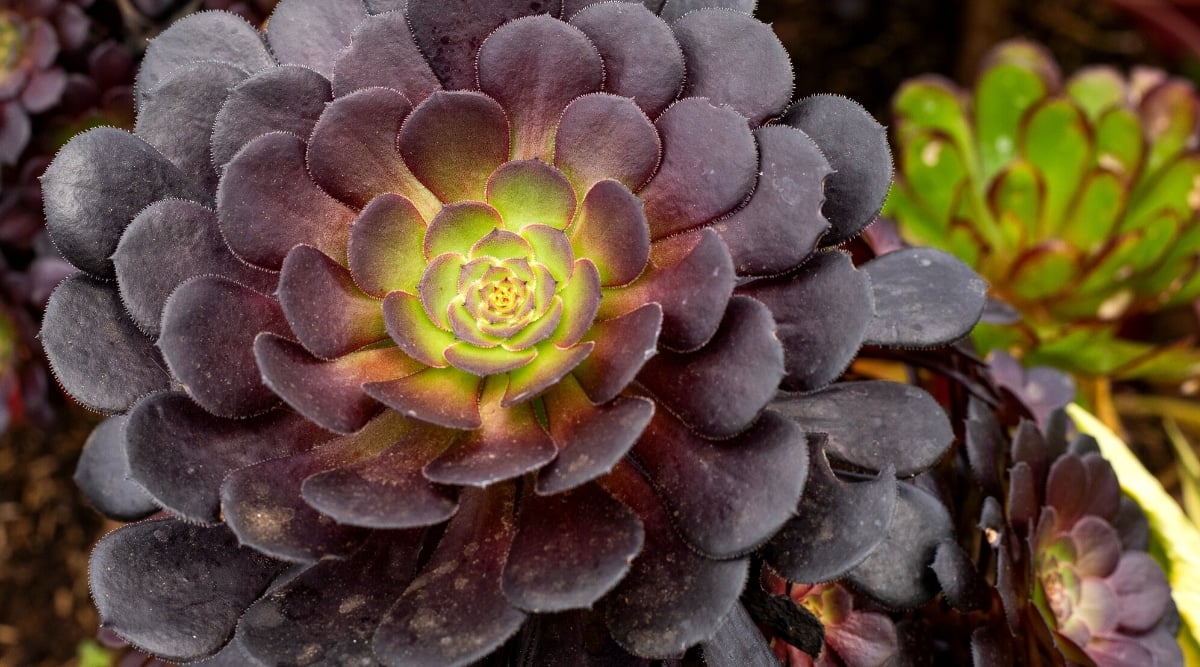
The succulent known as Black Rose or Black Tree Rose, called ‘Zwartkop’, transforms into a deep red color that intensifies to a nearly blackish shade under full sun exposure. Requiring more water compared to typical succulents, this plant thrives best when propagated through cuttings rather than offsets. Characterized by its tall and branching structure that can grow up to 4 feet in height, the Black Rose showcases yellow summer blooms that beautifully complement its deep-hued foliage. Sempervivum Heuffelii ‘Bora’ 
‘Bora’ is a stunning variant of Sempervivum heuffelii that undergoes a color transformation, starting with a vivid green heart that evolves into a dark purple tint by winter. This plant forms neat rosettes with delicate cilia along the edges. Upon maturity, this succulent blooms with yellow flowers before the rosette expires, making room for offsets to grow abundantly, establishing a cluster of these resilient plants. Broadleaf Stonecrop 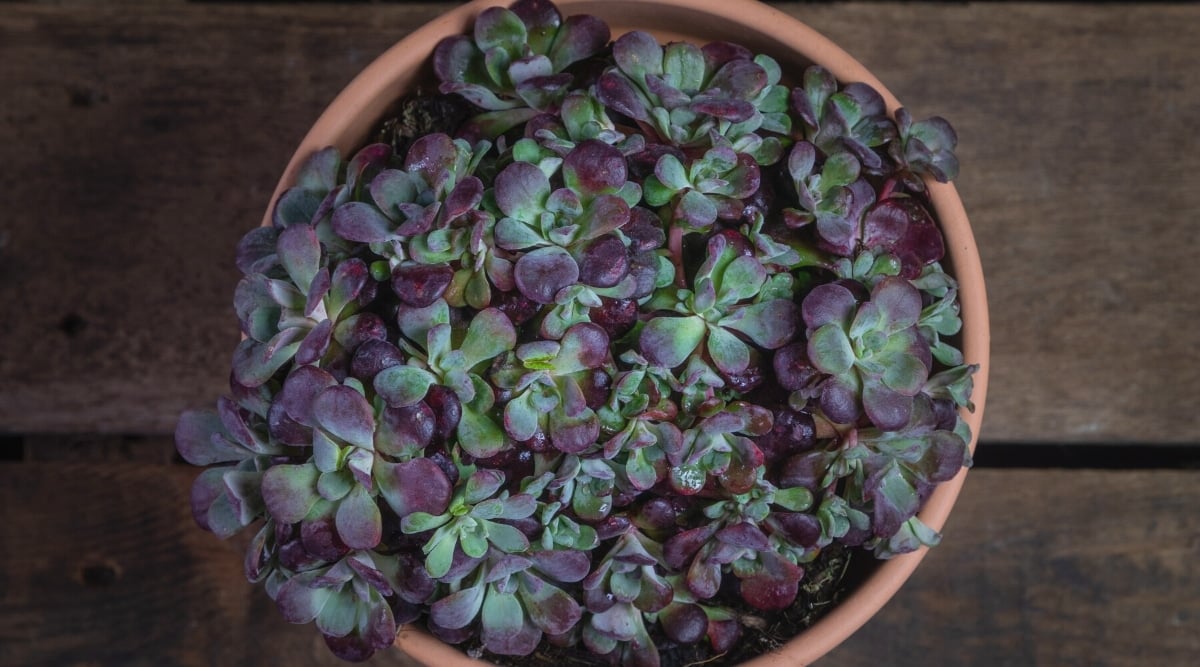
This remarkable plant, a native North American, is an award-winning specimen that draws butterflies and serves as an exquisite ground cover. Its cold-hardiness, coupled with the vibrant yellow blooms it produces during late spring and summer, make it a standout in any garden setting. Featuring fleshy, silvery leaves with a purple edge, this Sedum species forms rosette-shaped clusters that enhance the charm of rock gardens as it spreads elegantly, creating a visually appealing carpet of spoon-shaped foliage. Echeveria ‘Chroma’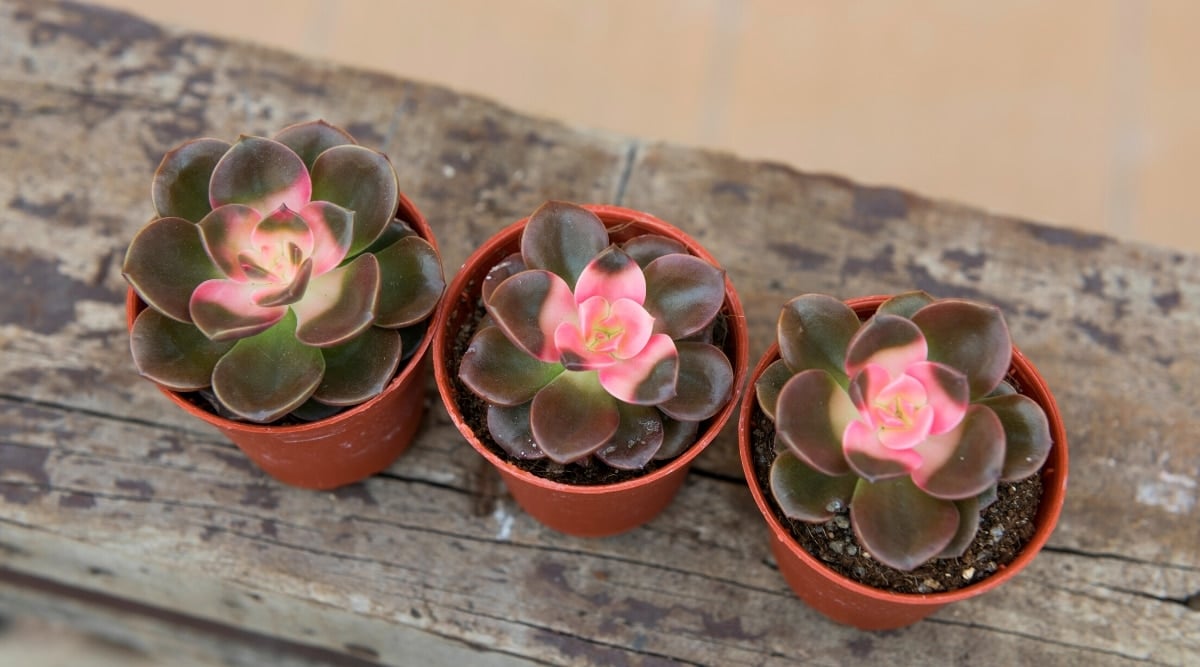
Echeveria ‘Chroma’ showcases a splendid array of hues, including purple, pink, green, apricot, gold, and white, making it a visually captivating plant. The rosettes, bell-shaped and small in size, exhibit a gradient of colors from the center outwards, intensifying with exposure to sunlight. In the spring, ‘Chroma’ adorns itself with flower spikes crowned with yellow and coral-colored bell-shaped flowers. Dragon’s Blood Sedum
Dragon’s Blood, also known as Caucasian Stonecrop, is a recipient of the Royal Horticultural Society’s Award of Garden Merit. It forms a carpet-like growth with clusters of green leaves that transition from red to purple at the edges depending on light exposure and the time of year. Sedum plants exhibit great resilience and are low-maintenance, with high tolerance for neglect and minimal susceptibility to pests and diseases. Dragon’s Blood displays attractive red flowers in the spring season. Graptoveria ‘Debbie’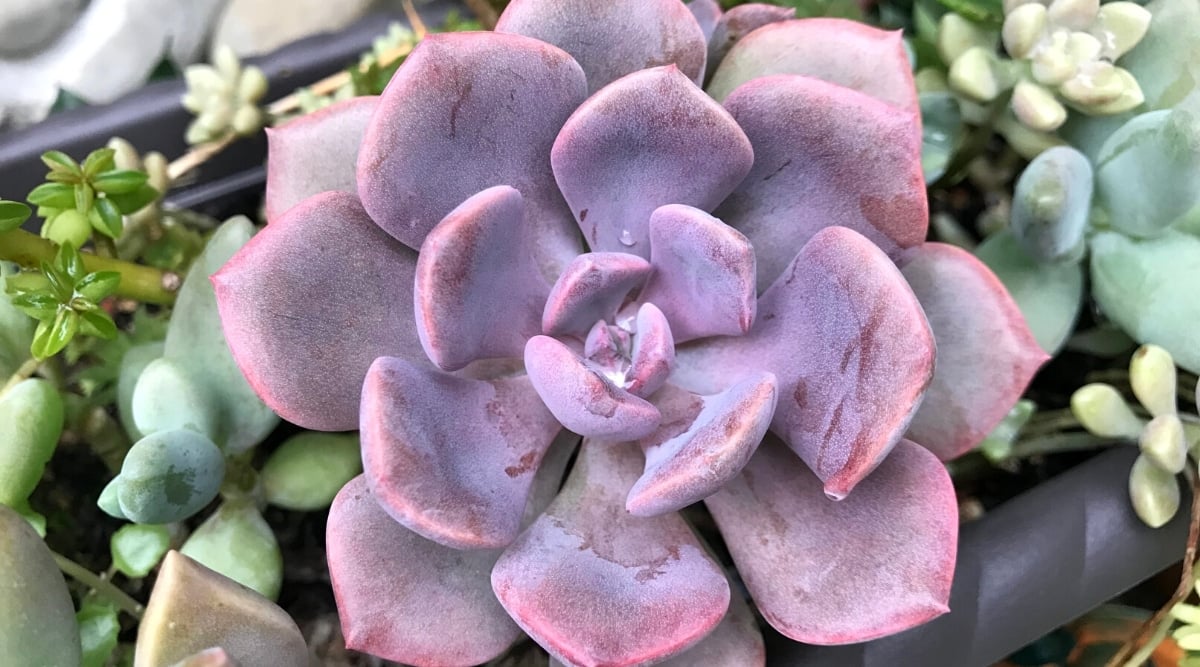
|
|
botanical name Sempervivum heuffelii ‘Hot Lips’ |
|---|
|
|
sun requirements Full Sun to Part Sun |
|---|
Houghton’s Hybrid Kalanchoe


|
|
botanical name |
|---|
|
|
Botanical Name Sedeveria ‘Jet Beads’ |
|---|---|
|
|
Sun Requirements Full Sun to Part Sun |
|
|
Hardiness Zones 9-11 |
Sedeveria ‘Jet Beads’ is a small bright succulent with green fleshy leaves that darken to almost a black shade of purple. This hybrid between sedum and echeveria makes a great hanging container plant with its creeping habit and produces attractive yellow flowers in the summer. It is easy to grow and care for, thriving in various light conditions but displaying its most vibrant colors when exposed to abundant sunlight. Propagation is also simple as it roots easily from cuttings by inserting a stem end into moist soil.
Sempervivum Heuffelii ‘Job’s Beard’

This variation of Sempervivum heuffelii displays a vibrant green shade with purple accents on its fleshy leaves. Referred to as hens and chicks due to its propensity for producing numerous closely clustered offspring, ‘Job’s Beard’ features a radiant light green center surrounded by deep purple-tipped succulent leaves.
Sempervivum ‘Killer’

The Sempervivum ‘Killer,’ is a striking succulent featuring a dense rosette comprised of fleshy olive green leaves adorned with purple spots. This variety is known for its robust and unique appearance that adds a touch of elegance to any garden setting.
|
|
botanical name Sempervivum heuffelii ‘Job’s Beard’ |
|---|---|
|
|
sun requirements Full Sun to Part Sun |
|
|
hardiness zones 4-9 |
‘Killer’ is a stunning hybrid Sempervivum with a unique leaf pattern and eye-catching colors. Its name adds a playful touch to its already charming appearance.
With a bullseye pattern, ‘Killer’ displays purple leaves at the base, green in the center, and purple edges, creating a visually appealing concentric ring effect as the leaves unfurl. This plant not only stands out for its aesthetics but also boasts impressive cold resistance.
Sedeveria ‘Lilac Mist’

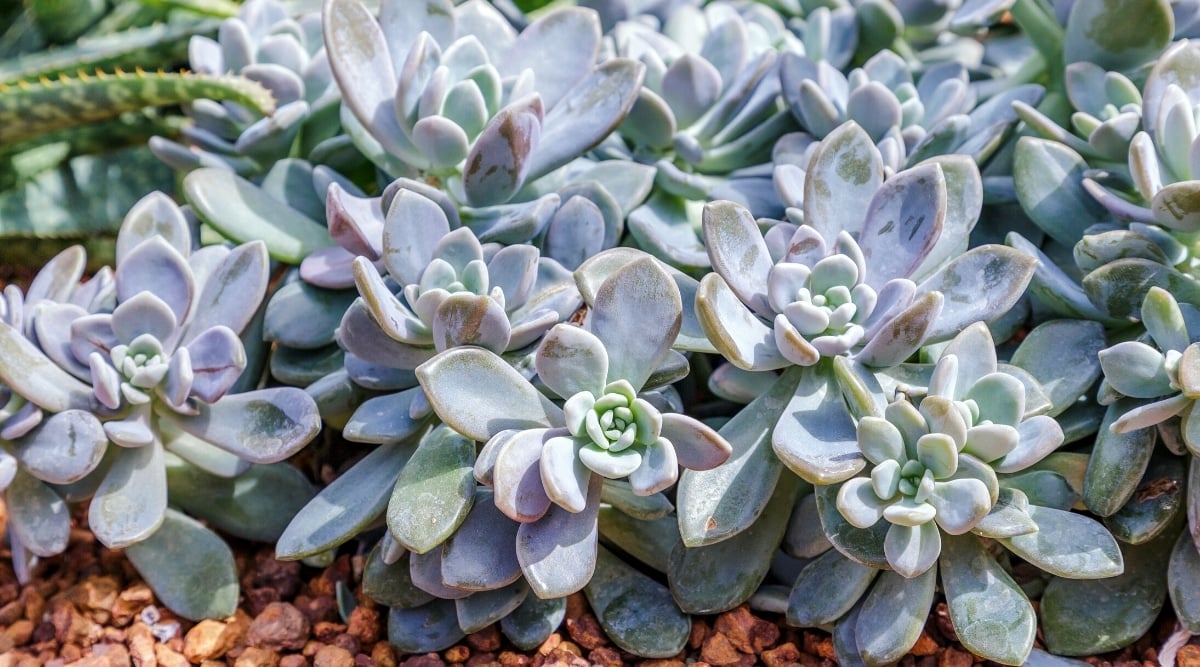
|
|
botanical name Sedeveria ‘Lilac Mist’ |
|---|---|
|
|
sun requirements Full Sun to Part Sun |
|
|
hardiness zones 8-11 |
‘Lilac Mist’ thrives in various light conditions and adapts well indoors due to its tolerance for low light levels. While it may not withstand cold temperatures, its robust leaves in shades of light green to lilac and their fuzzy texture offer protection against excessive sunlight. Sedeveria plants, including ‘Lilac Mist,’ require infrequent watering and are easy to care for, with this variety growing up to 2’ tall. During early summer, it blooms with predominantly white flowers that may also appear in pink or purple hues.
Sedum Dasyphyllum ‘Lilac Mound’

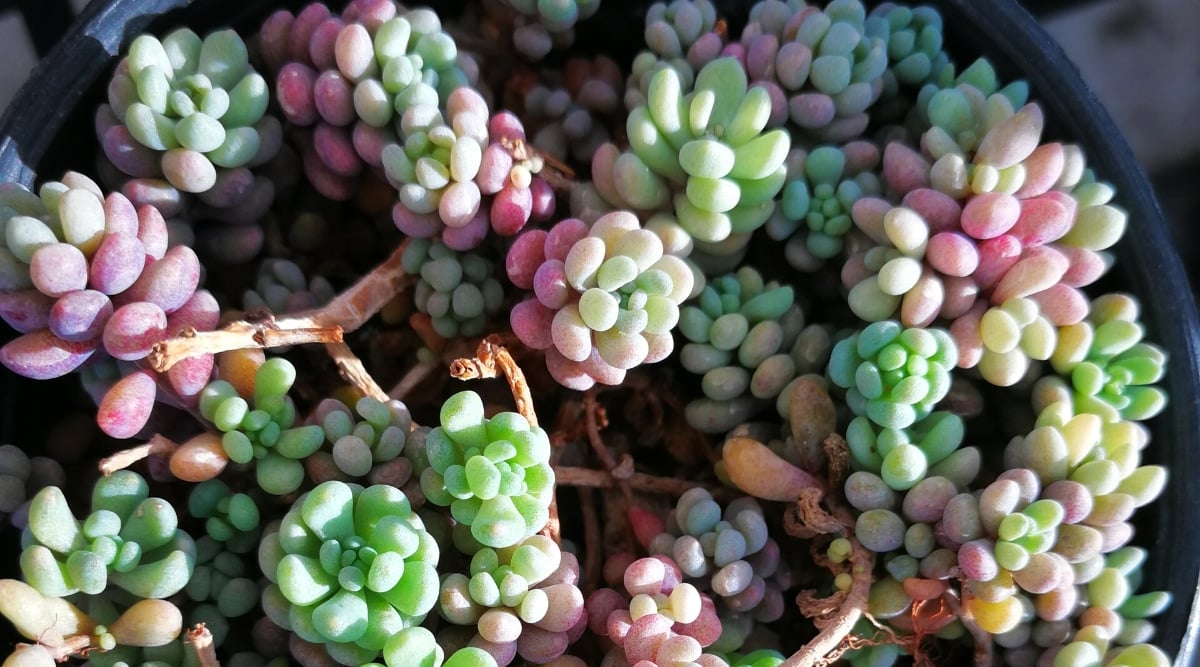
|
|
This sedum, known as Sedum dasyphyllum ‘Lilac Mound,’ resembles the popular Burro’s Tail succulent. While its stems may not grow as long as the Burro’s Tail, their leaf formation is quite similar. With a mounding growth habit, ‘Lilac Mound’ forms a cluster of delicate structures. The fresh growth starts off green but quickly transitions to a lovely plum hue. Mangave ‘Macho Mocha’ 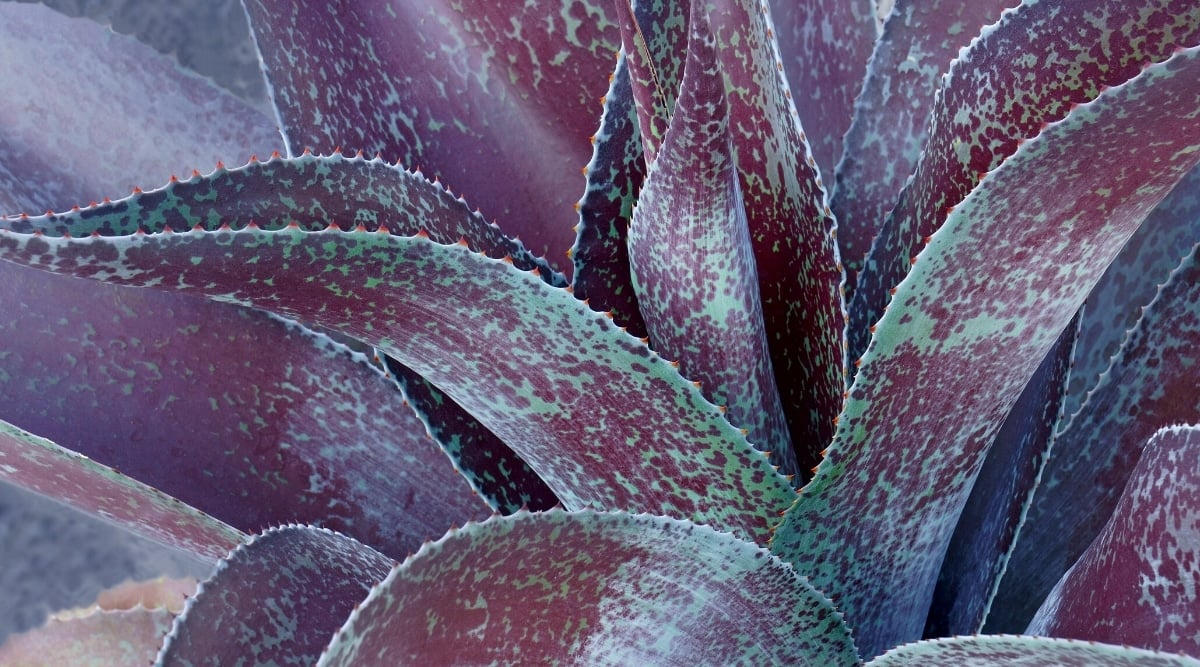
Mangave plants are a recent hybrid combining Agave and Manfreda, displaying the robustness of Agave and the vibrant color patterns of Manfredas. These plants typically grow individually until flowering, after which they develop offsets that can be left to cluster or transplanted into separate areas. A moderate-sized plant, ‘Macho Mocha’ reaches 1’-2’ in height and width. Its blossoms are particularly appealing to hummingbirds. The foliage features palm-like leaves that transition from green at the center to purple speckles and then solid purple at the leaf tips. Mangave ‘Mission to Mars’
Mangave ‘Mission to Mars’ belongs to the fascinating hybrid Mangave species, renowned for their ease of cultivation and unique appearance. These perennials exhibit remarkable texture, perfect for borders or centerpieces, and develop excellent drought resistance once matured. Pachyphytum Oviferum ‘Moonstones’
Hardiness Zones10-11 Also known as ‘Sugar Almonds’, the ‘Moonstones’ succulent is indigenous to Mexico. It goes dormant in summer and showcases beautiful white and red blooms during late winter and early spring. The rounded, small leaves take on a lavender hue in bright sunlight, appearing frosted and light when wet.
Sempervivum Heuffelii ‘Mystique’ 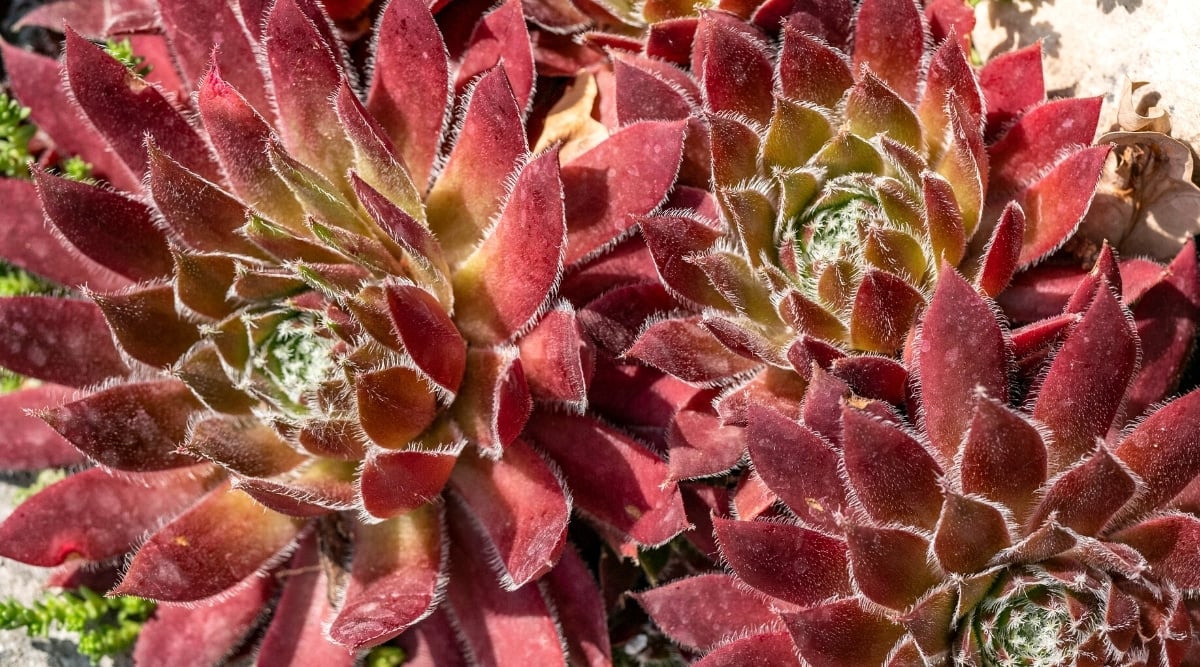
The ‘Mystique’ succulent, a part of the Sempervivum species, is another resilient plant that is colorful year-round. It thrives in sunny spots and well-drained soil. What sets it apart is its remarkable ability to withstand cold temperatures.
Echeveria ‘Perle von Nurnberg’ is a stunning succulent variety with pale blue-violet leaves that form a loose rosette. Its smooth leaves resemble porcelain, taking on a gray hue in low light but becoming more vibrant in the sun. During summer, it produces pink flowers with yellow interiors on tall stems. Echeveria plants, including ‘Perle von Nurnberg,’ continue to thrive even after blooming and can live for decades with proper care. Sempervivum Tectorum ‘Purple Beauty’
House Leek, also known as ‘Purple Beauty,’ belongs to the Sempervivum tectorum species, translating to ‘always living on roofs’ in Latin. This hens and chicks variety produces numerous offsets, creating clustered mounds of partially open rosettes. Changing hues with the seasons, the leaves typically exhibit purple tips and in mid-summer, they sprout stems adorned with softly whiskered leaves. At the top of these stems, clusters of small pink flowers resembling asters bloom. Graptopetalum ‘Purple Delight’
For novice plant enthusiasts, ‘Purple Delight’ is an ideal option. This plant thrives with minimal care and flourishes as an indoor plant on a sunlit windowsill. Commonly referred to as Snow White, its hues vary from lavender-gray to frosted white. The plant blossoms charming white flowers speckled with red spots and easily propagates through leaf cuttings. It’s crucial to shield them from temperatures below 30°F during the colder months as they are not cold-resistant. Hylotelephium Telephium ‘Purple Emperor’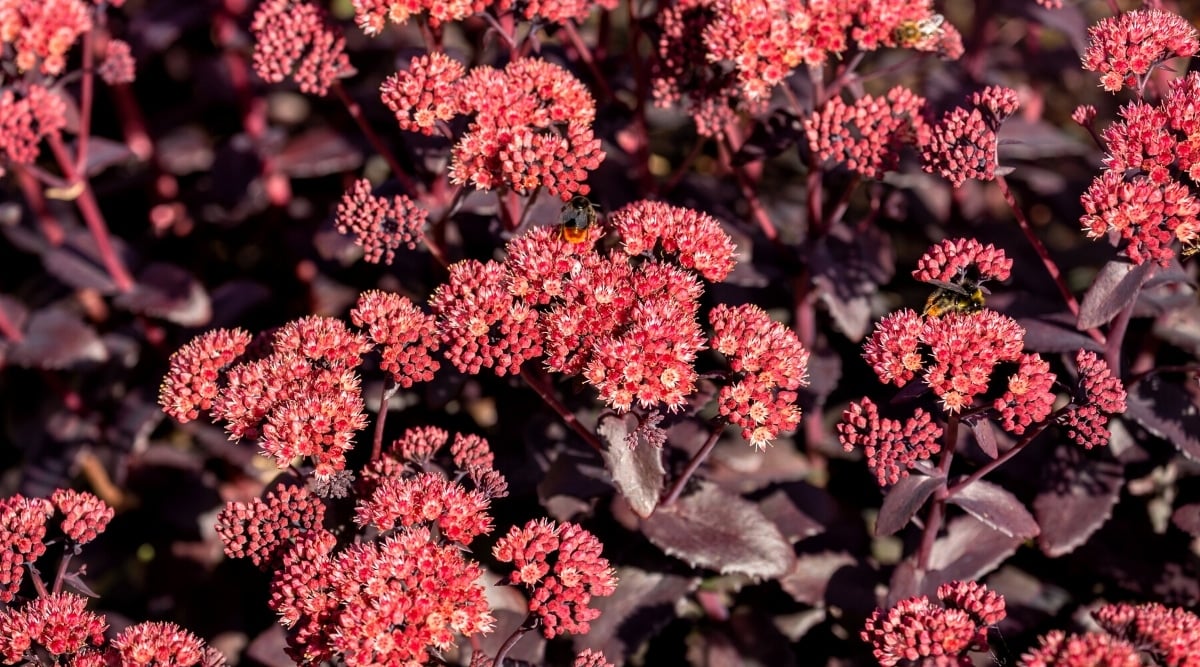
Hailing from the sedum family, ‘Purple Emperor’ boasts hardy and easy-to-maintain characteristics. Recognized with the Award of Garden Merit by the Royal Horticultural Society, its beauty speaks for itself. This variety showcases mesmerizing aubergine-hued leaves and blooms profusely with dainty pink flowers that endure well into late fall. Graptopetalum ‘Purple Haze’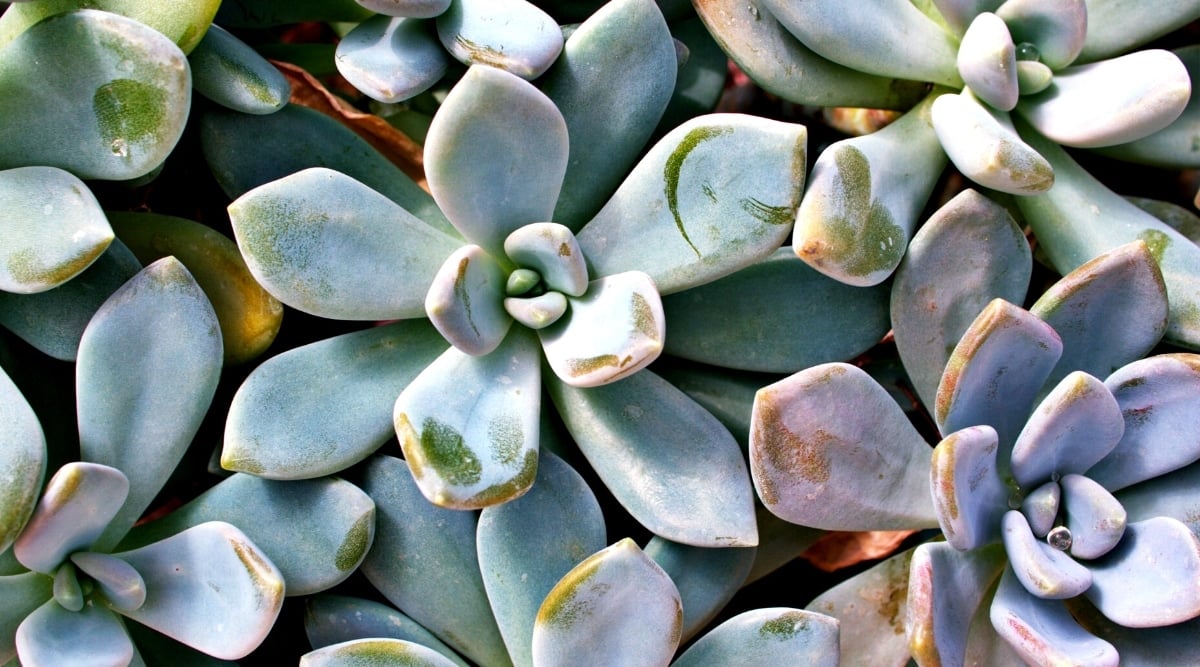
The captivating Graptopetalum ‘Purple Haze’ boasts softly colored fleshy leaves arranged in a loose rosette. Their striking pale gray color with lavender edges intensifies seasonally, providing an easy-to-care-for eye-catching addition to your garden. This variety is known for its lovely little lavender flowers in the spring. Featuring tiny white, star-shaped blooms with subtle red flecks, these flowers add a delicate touch to its appearance. Purple Heart
Purple Heart, with its spidery, trailing growth, showcases a deep purple hue and unique oblong rosette leaf formations, making it a stunning groundcover choice. In the summer, it produces pretty pinkish purple flowers that beautifully complement its overall appearance. This resilient succulent is usually hardy in zones 10-11, but surprisingly withstands colder temperatures, returning in spring even in zone 8. While not evergreen above zone 10, it’s worth noting that it’s a recipient of the RHS Award of Garden Merit. Echeveria ‘Purple Pearl’
Echeveria ‘Purple Pearl’ is a variant of Perle von Nurnberg, with deeper purple leaves and a touch of magenta on the edges. Their structure, size, and shape are almost identical, except for the color variation. This plant boasts coral-colored flowers. Purple Rose Tree
Distinctively known as Black Rose, Purple Rose, or Black Beauty, this unique succulent flaunts deep purple tones in its oxblood rosettes that sit atop lofty stems, resembling sunflowers in appearance. Thriving in light shade and advising against excess watering, the Purple Rose Tree reveals delicate white blooms in early summer before entering its dormancy phase, requiring minimal watering during the summer. Sempervivum ‘Raspberry Ice’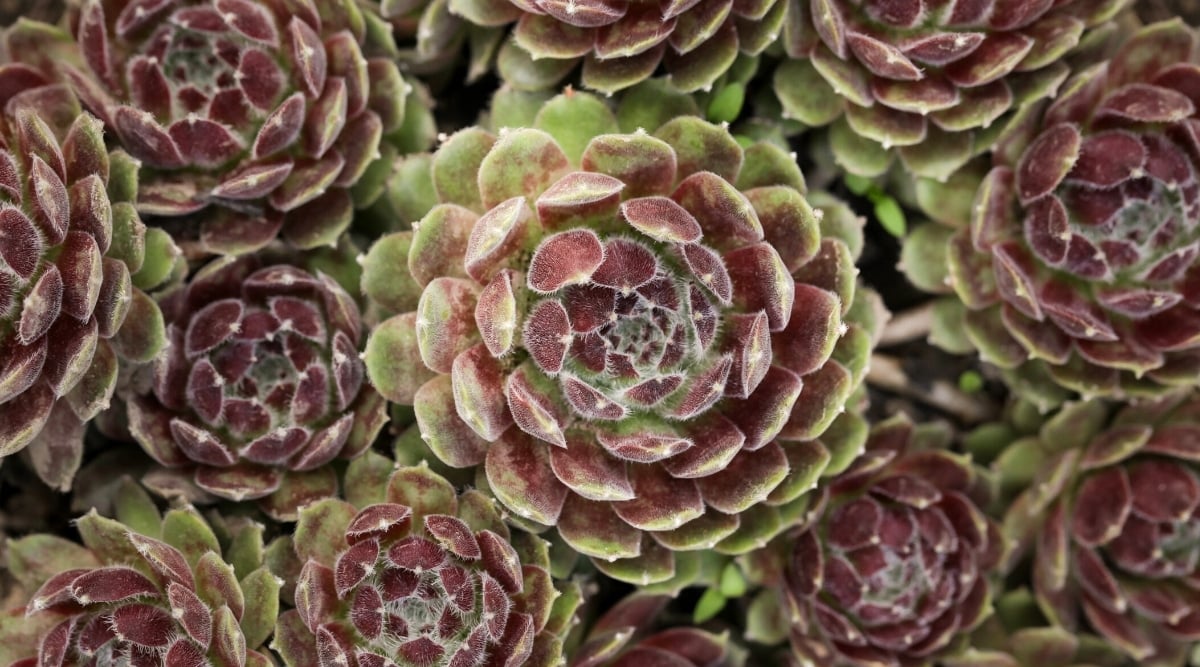
This spider-like succulent, native to Europe, is extremely cold-resistant. The ‘Raspberry Ice’ variety boasts smooth, deep purple leaves adorned with a hint of white fuzz outlining the edges, resembling a frosty appearance. Developing offsets on elongated purple stems, ‘Raspberry Ice’ gradually intensifies in purple hue, transitioning to a striking deep purple-black shade over time. Echeveria Agavoides ‘Romeo’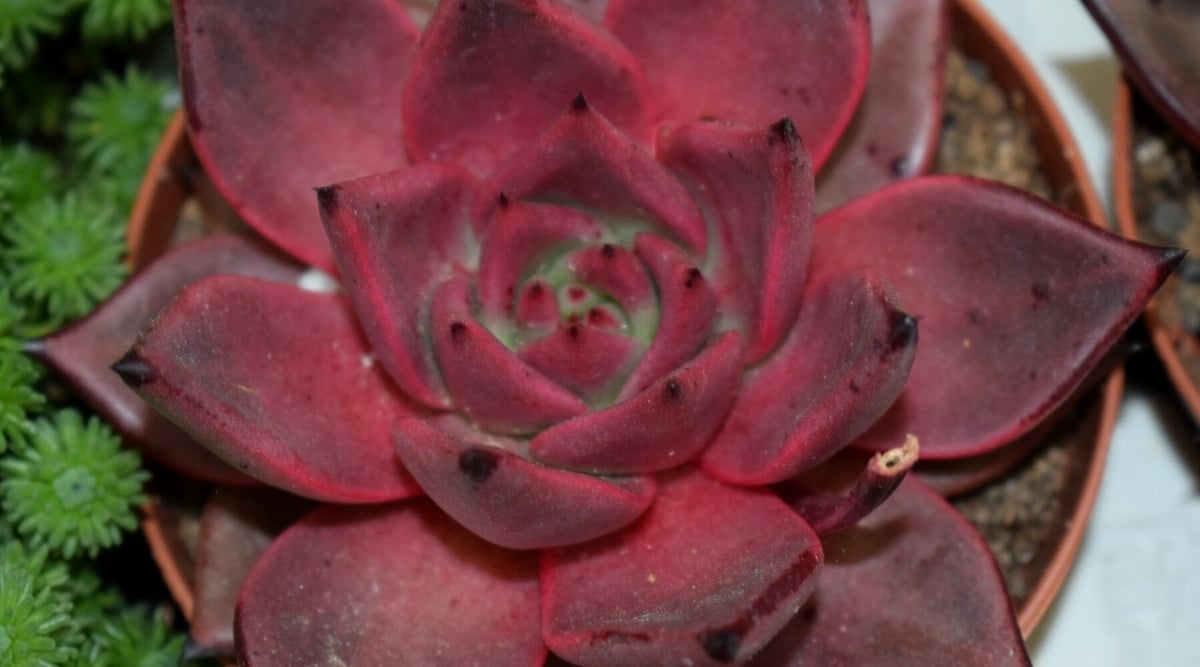
|
|
sun requirements Full Sun to Part Sun
|
|
hardiness zones 9-11 One of the most striking succulents, ‘Romeo’ is a variety of echeveria known for its deep burgundy color. With spiky leaves forming a tight rosette, this plant thrives in sunlight, intensifying its hues from smoky green to reddish-purple as it matures. While ‘Romeo’ blooms in late spring and summer, its flowers are smaller than other echeverias, appearing in red with yellow tips. However, the real standout features are its chubby, colorful leaves that steal the spotlight. Pleiospilos Nelii ‘Royal Flush’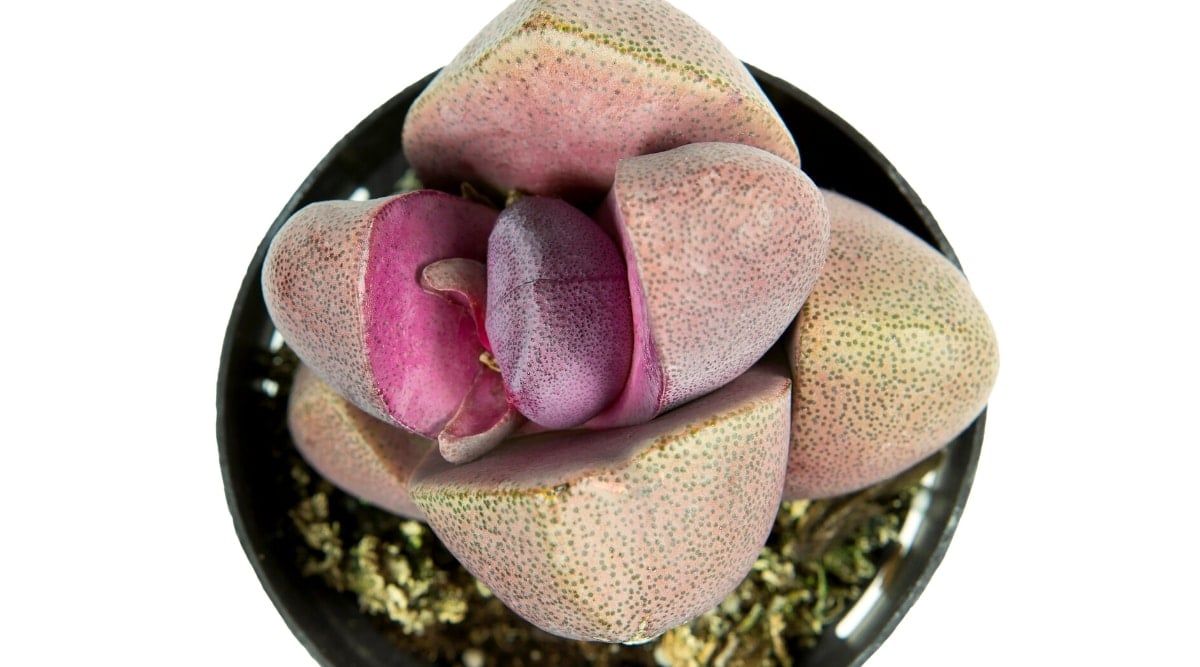 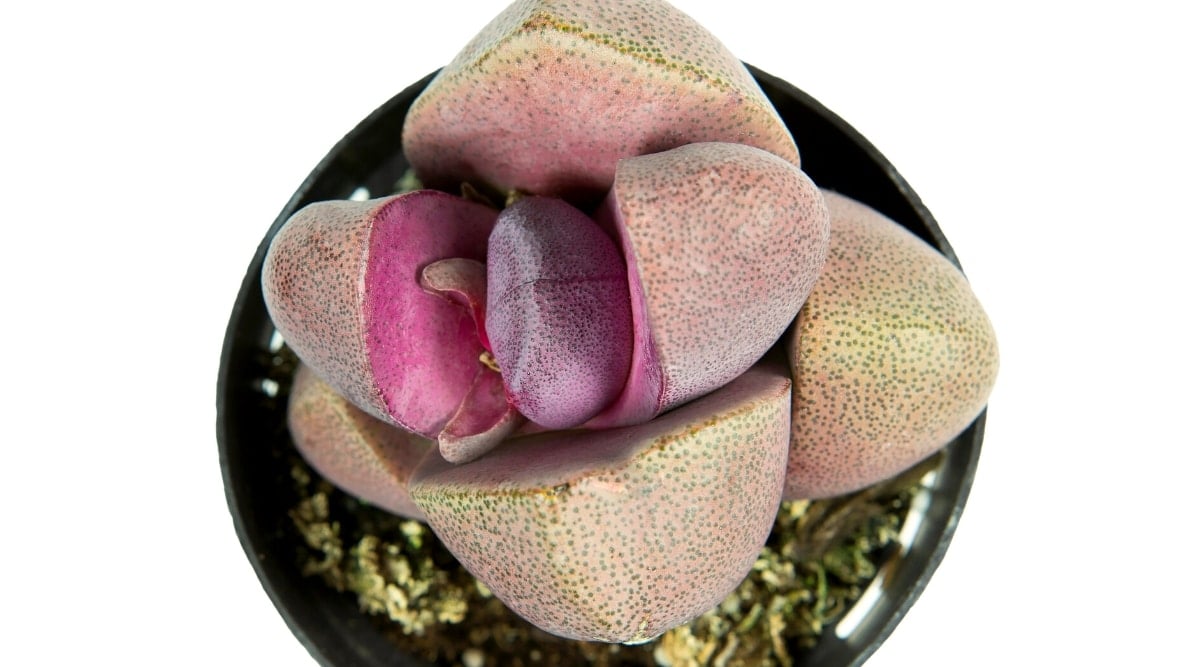
Known as Split Rock plants, Pleiospilos are small succulents reminiscent of rock trolls from Frozen due to their size and appearance. These plants grow up to 3” tall and originate from South Africa. The ‘Royal Flush’ variety displays a soft greenish-purple hue and blooms with charming pink flowers in early spring. Resembling tiny daisies, the flowers feature bright pink petals with yellow centers. This plant is a delightful novelty that thrives in various light conditions, including artificial lighting. Lithops Optica ‘Rubra’ 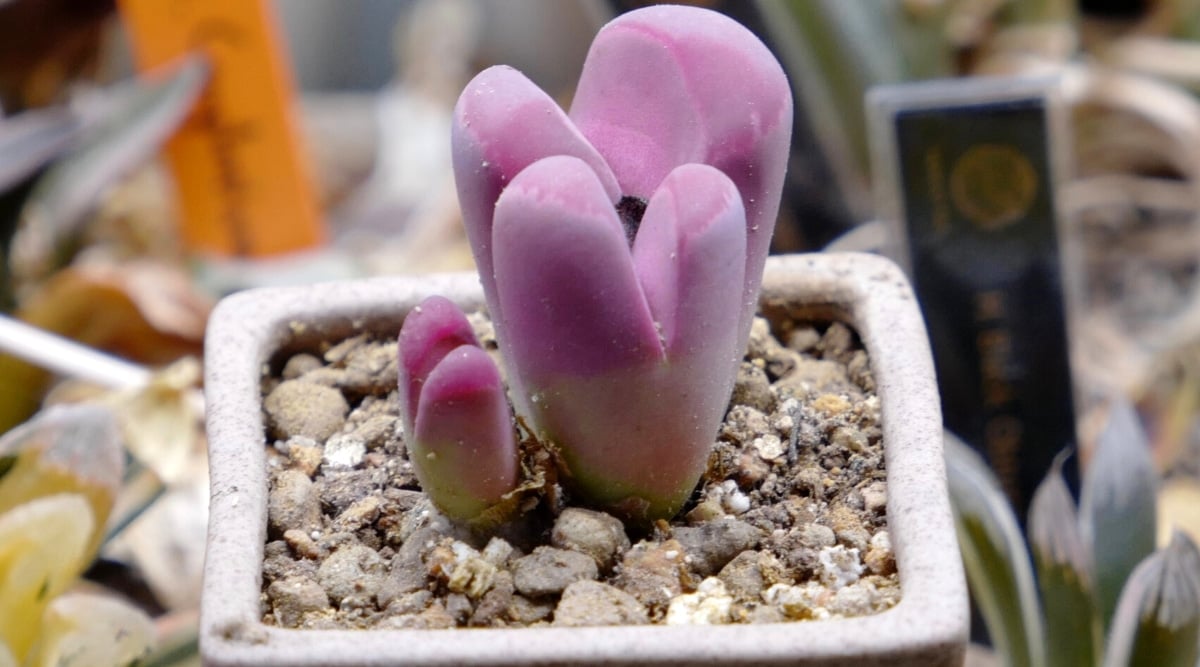
Living Rock plants like Lithops, similar to Pleiospilos, mimic rocks. ‘Rubra’ features a deep purple hue with two fleshy lobes that reveal a white flower in late summer. Placed in areas with ample sunlight, ‘Rubra’ thrives. It goes dormant during the summer and blooms early in the growing season. In winter, it requires more watering, but caution should be taken as this succulent can be prone to overwatering damage. Othonna Capensis ‘Ruby’s Necklace’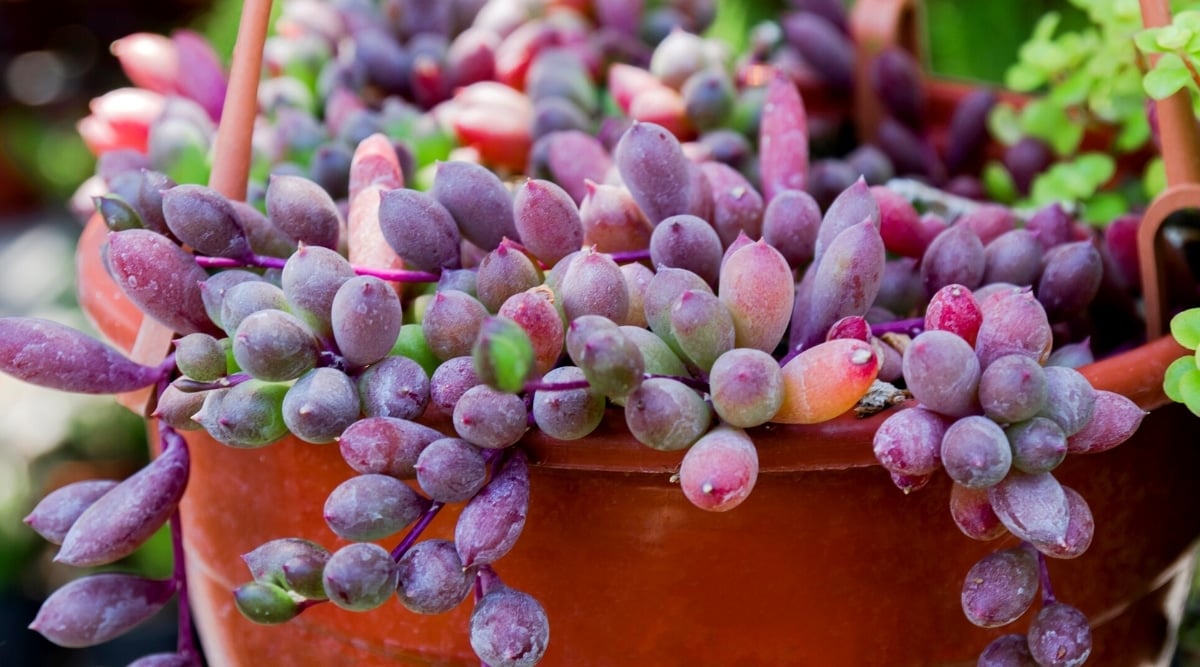 
When it comes to my wish list for plants, ‘Ruby’s Necklace’ definitely makes the cut! This lovely hanging succulent belongs to the Aster family, sporting delightful yellow daisy-like blossoms. Its green leaves with a hint of purple take on richer hues when exposed to sunlight, complemented by vibrant magenta-purple stems. While maintaining the happiness of this trailing plant indoors may pose a challenge, it’s entirely feasible. Commonly known as String of Pickles, this plant thrives with ample indoor light and full to partial outdoor sun exposure. Adhering to typical succulent watering guidelines is crucial to avoid root rot, making neglect in watering a key aspect for success. Santa Rita Prickly Pear
The visually captivating Santa Rita prickly pear not only adds beauty to your garden but is also edible! These ornamental cacti boast colorful, fleshy pads round the year in an outdoor setting. Due to their size, they are more suited for outdoor growth and can thrive in diverse climates. Initially jade-colored, the paddles gradually transition to a vivid violet in sunlight. The vibrant yellow blooms make a striking appearance during spring, enhancing the overall appeal of this succulent garden centerpiece. Low-maintenance and visually stunning, these plants are sure to impress. Sedeveria ‘Sorrento’
Presenting Sedeveria ‘Sorrento’ – a botanical name that signifies a captivating blend of Sedum and Echeveria species. This hybrid boasts both ease of cultivation and propagation. While not highly cold-resistant, they can endure outdoor conditions down to 32°F. Shedding leaves in winter, these resilient plants rejuvenate with the arrival of spring.
To flourish, ‘Sorrento’ demands abundant sunlight and minimal watering. Enhanced exposure to sunlight results in a delightful color transformation from green to deep red-violet. Once well-established, these plants exhibit high drought tolerance and resist overwatering-induced demise.
Thriving in hardiness zones 10-12, ‘Sorrento’ demonstrates adaptability to varied environmental conditions, making it a versatile addition to gardens. Final ThoughtsPurple succulents introduce a captivating allure and vibrancy to any succulent ensemble. With ease of maintenance and a penchant for neglect, these indoor-friendly plants offer a spectrum of evolving hues, evolving from vivid greens to deep red-violets. Inspiration and charm are guaranteed with these purple succulents, a testament to their ability to surprise and enchant effortlessly. Latest posts by JAMES (see all) |
|---|


